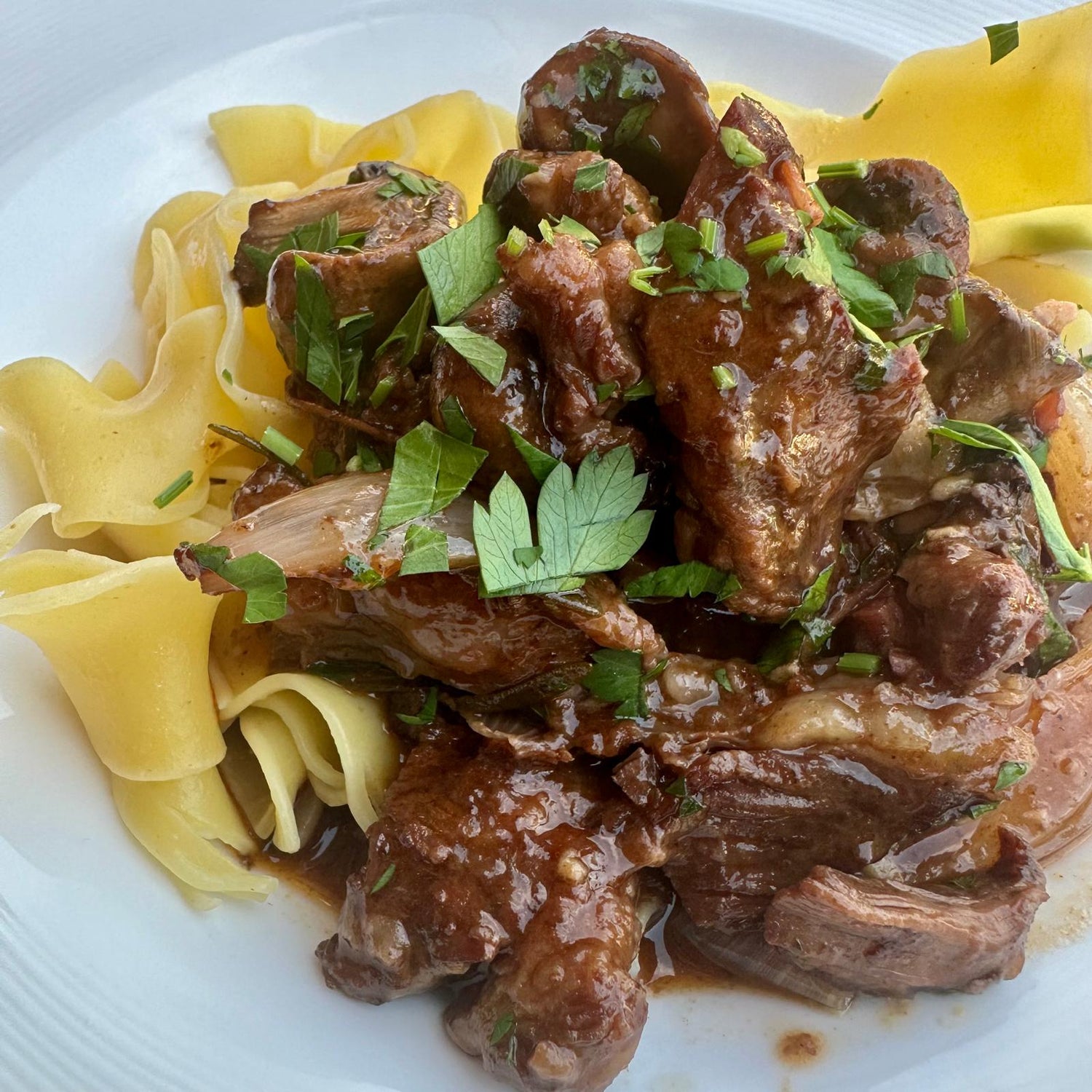
The Ultimate Step-by-Step Guide to Brining Food
Share
The Ultimate Step-by-Step Guide to Brining Food: What It Is and Why You Should Do It
Brining is one of the best-kept secrets in the culinary world, used by professional chefs to elevate the flavor, tenderness, and moisture of various meats and vegetables.
If you're looking to bring a restaurant-level quality (read: more moisture!) to your otherwise 'dry' or 'lean' meats, learning how to brine is a game-changer.
This guide will walk you through the step-by-step process of brining and explain why it makes such a difference.
What Is Brining?
At its core, brining is the process of soaking food in a solution of water, salt, and sometimes sugar or other flavourings.
This simple technique does wonders for food by enhancing flavour and moisture. Think grade 9 science, the process of osmosis: the salt acts on the meat allowing moisture to enter into the meat fibres. Sometimes the amount of salt can seem daunting. But if you don't use the correct amount you are just wasting your time (and money!)
While most commonly used for meats such as chicken, turkey, and pork, you can also brine vegetables and fish. We started brining calamari a few years ago after asking a chef in Kentucky why is calamari was so tender!
Why Brining Is a Game-Changer
Moisture Retention
Brining helps your food retain moisture during cooking. The salt in the brine penetrates the cells of the food, drawing water in and locking it inside. This is especially helpful for meats that tend to dry out, like turkey, chicken breast or pork chops.
The result? Juicy, flavorful dishes every time. An overcooked brined turkey will be more moist than a perfectly cooked unbrined turkey!
Flavour Enhancement
Besides adding moisture, brining boosts flavour. Salt and any other spices or herbs in the brine get absorbed, seasoning the food from the inside out. This makes every bite more flavourful, not just the surface.
Improved Texture
Brining breaks down some of the proteins in the meat, making it more tender. This is particularly beneficial for lean proteins, turning them into melt-in-your-mouth meals.
Step-by-Step Guide to Brining
Step 1 – Gather Ingredients & equipment
Before you begin, make sure you have these basic ingredients:
- Water (cold or room temperature)
- Kosher salt or sea salt. Our testing is always done with Diamond Crystal Kosher Salt.
- Optional: sugar, herbs, and spices (such as garlic, peppercorns, bay leaves, thyme). Citrus is nice as well, orange slices for turkey for instance.
- Something to brine in: this will obviously depend on what you are brining, but something non-reactive such as plastic or stainless steel. Smaller cuts work well in your basic tupperware, and turkeys work well in large buckets such as this one. As restaurant owners we acquire buckets like this all of the time, as large amounts of oil come in these. If you know someone in the industry, ask them for a bucket! The other option, as discussed below, is to use a cooler.
Step 2 – Measure Your Ingredients
The standard ratio for a basic brine is:
- 4 cups (1 L ) of water
- 1/4 cup (50g) Kosher salt
- 1/4 cup sugar (optional, but great for adding a subtle sweetness)
A typical brine amount for a large turkey is based on 10-12 L of water.
Step 3 – Dissolve the Salt and Sugar
In a large container, dissolve the salt (and sugar, if using) in the water. You can either stir it well in cold water or heat up half of the water, dissolve the salt and sugar, then add the remaining water (or ice!) to cool it down.
Step 4 – Add Flavour Enhancers (Optional)
For extra flavour, toss in spices, herbs, or aromatics. Some popular options include:
- Garlic cloves
- Black peppercorns
- Bay leaves
- Fresh herbs like rosemary or thyme
- Citrus zest or slices (lemon, orange, or lime)
Step 5 – Submerge the Food
Place your food (meat, fish, or vegetables) into the brine, ensuring it’s fully submerged. You may need to weigh it down with a plate to keep everything under the liquid. When it comes to a whole turkey this can often be a challenge: where can I fit a whole turkey in a bucket?? One option that we have come across over the years is to brine in a cooler, using ice cubes for about half of your total liquid amount.
Step 6 – Refrigerate and Let It Brine
Once your food is in the brine, refrigerate it. The time required depends on the type of food:
- Chicken breasts: 1-2 hours
- Whole turkey: 12-24 hours
- Pork chops: 1-2 hours
- Fish fillets or seafood: 15-30 minutes
- Vegetables: 30-60 minutes
Step 7 – Remove, Rinse, and Cook
After brining, remove the food from the solution and rinse it under cold water. To be honest, rinsing a whole, giant turkey can also be problematic and logistically difficult. Our preference is to carefully remove the turkey from the brine and place right in your roasting pan lined with a rack. Get this in your refrigerator overnight, uncovered. This is an ideal situation. Have we removed the turkey from the brine and roasted the same day? Yes. Pat it dry well with paper towel and roast away, your skin may just now brown up as well.
Frequently Asked Questions About Brining
Can You Over-Brine?
Yes! Over-brining can make your food too salty or cause the texture to become mushy. Always stick to the recommended times for each type of food.
Should I Brine Every Meat?
While brining works wonders on lean cuts like poultry and pork, it’s not always necessary for fattier cuts, such as steak. However, it’s perfect for turkey, chicken breasts, and pork chops, which tend to dry out during cooking.
What’s the Difference Between Wet and Dry Brining?
In wet brining, food is submerged in a saltwater solution. Dry brining, on the other hand, involves rubbing the food with salt and allowing it to rest without liquid. Both methods work to improve flavor and texture, but wet brining adds more moisture.
Conclusion
Brining is a straightforward but incredibly effective technique that can take your your next roast or grilled chop to the next level. Whether you’re preparing chicken for dinner, getting ready for Thanksgiving, or just experimenting with vegetables, brining will enhance the flavour, tenderness, and moisture of your food. Now that you know the basics, it's time to start brining and enjoy chef-quality meals at home!
Ready to Brine Like a Pro?
Let us know how your first brining experience goes! Drop your questions in the comments below or share your brining tips.
For more expert cooking techniques, don’t forget to subscribe to our newsletter for weekly chef-inspired tips and recipes!



